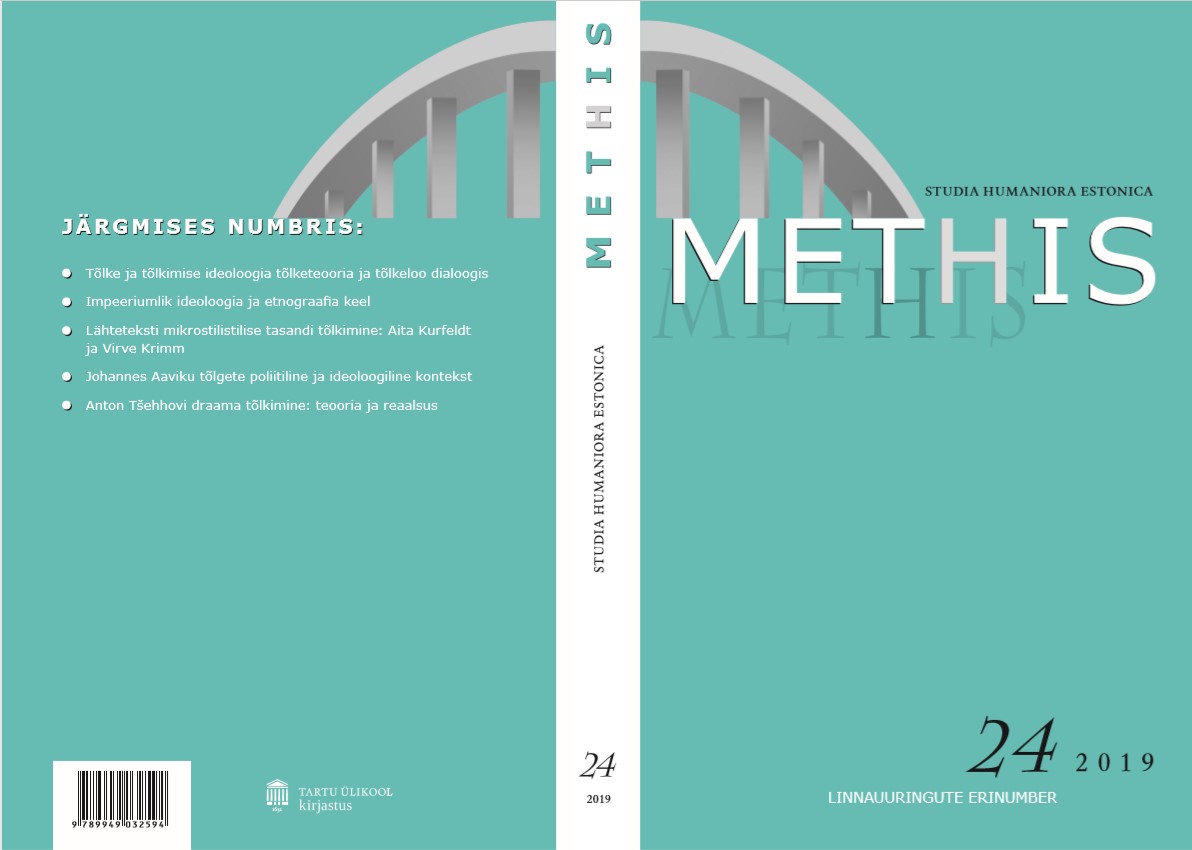Baltisaksa piirilinn. Eduard von Stackelbergi ja Monika Hunniuse Narvad / A Baltic-German Border Town: Eduard von Stackelberg’s and Monika Hunnius’s Narvas
DOI:
https://doi.org/10.7592/methis.v19i24.16197Keywords:
Baltisaksa kultuur, mälestused, kultuurilugu, Narva linn, Baltic-German culture, memoirs, history of culture, NarvaAbstract
Käesolev artikkel käsitleb piirilinna Narva kujutamist kahe baltisaksa autori – laulja ja laulupedagoogi Monika Hunniuse (1858–1934) ning provintsiaalpoliitiku Eduard von Stackelbergi (1867–1943) mälestustes. Nende lapse- ja nooruspõlve meenutustest koorub välja baltisaksa Narva – linn, mida pärast II maailmasõda enam olemas ei ole ning mis on suuresti ununenud ka eesti kultuurimälus. Oma geograafilise asetuse ning arhitektuurilise ja kultuurilise mitmekesisusega joonistub Narvast valitud baltisaksa mälestustes välja oluline lääne kultuuri ja saksluse eelpost idas.
The article focuses on the border town of Narva as it emerges in the memoirs of two Baltic German authors – the singer and singing pedagogue Monika Hunnius (1858–1934) and the provincial politician Eduard von Stackelberg (1867–1943). Their recollections of their days of childhood and youth reveal a Baltic German Narva, a city that ceased to exist with World War II and has been largely wiped from Estonian cultural memory. Due to the city’s geographic position as well as its architectural and cultural diversity, these Baltic German memoirs provide a sketch of Narva as a city of symbolic value experienced as an outpost of German culture in the East.
Narva has been depicted by the historian of culture and author of non-fiction Erik Thompson in his albums of the city that highlight the specialness of the Baltic German Narva – the Western, German cultural space reached its limit in the border town, while beyond it, the Eastern, Russian cultural space began. The border town was also depicted in literary writings, many of them short poems. The memoirs of Monika Hunnius and Eduard von Stackelberg, however, contain a more extensive retrospective look at Narva as it was in their childhood and youth. Stackelberg went to school in Narva, residing with his parents at Sillamäe during the vacations, and left the city without regret, while Hunnius, who actually lived in the city, remembers it as a nostalgic home space full of sunshine to which she later longs to return.
The most important topics emerging from Hunnius’s and Stackelberg’s descriptions of Narva are connected with the town’s geographical location and its social-political conditions. The most significant among these are the river serving as a border, contrasts and confrontations, the German cultural space in Narva, religion as a phenomenon creating and breaking down boundaries, and the (lost) glory of Narva and its close vicinity.
For Stackelberg, Narva symbolises a strong border that has found expression in its geographical situatedness at the end of one cultural space and the beginning of another. He sees Narva as an outpost of German culture and his experiences there are coloured by conflicts with the students of the Russian school and the self-protection attempts of Germanness. Like Hunnius, he experiences buildings as symbols of a German Narva that today can only be considered a site in cultural memory. In addition, he creates an opposition between the baroque old town and the ‘ugly’ new suburbs; also, the ritual battles that take place between students are with the boys from the suburbs. As regards the border between the East and the West, Stackelberg even draws a parallel with ancient Rome and calls it a limes, thus comparing the Germans with Romans and the Russians with barbarians. By the time of Stackelberg, the city is declining as its commerce has shifted to Tallinn and St. Petersburg.
Due to the profession of Hunnius’s father, a Lutheran pastor, for her the scene of confrontations between the East and the West is that of the church where Russian Orthodoxy and Lutheranism clash. Although the boundary between different denominations is vague in Narva, even a positive contact with Russians through a beloved Russian nanny will not counterbalance the negative experience of an Orthodox service nor prevent the creation of a mental boundary between ’us’ and ’them’.
Neither of the memoirs is restricted only to the city of Narva: Hunnius’s childhood paradise also includes a summer house called Schmetzky close to the town, while Stackelberg describes the manor of Sillamäe and the atmosphere of the summer getaway, including an endless quarrel with the neighbours over the boundaries of the land.


